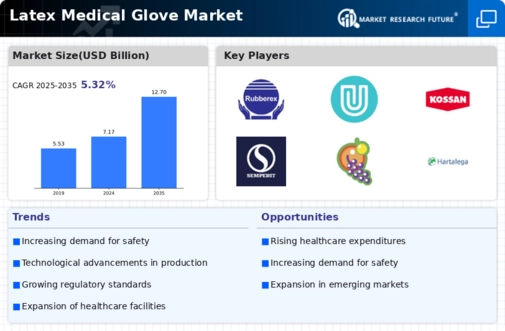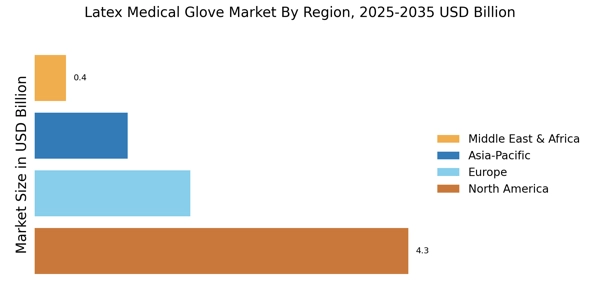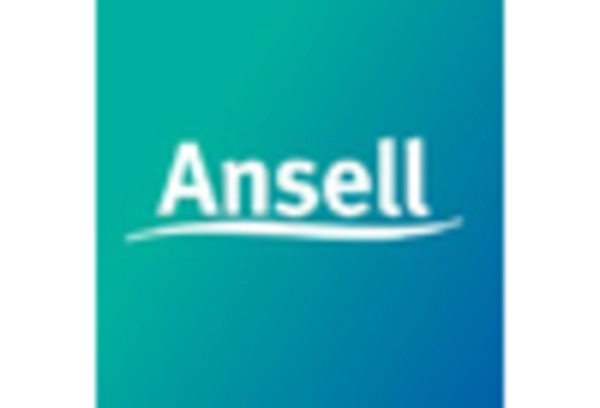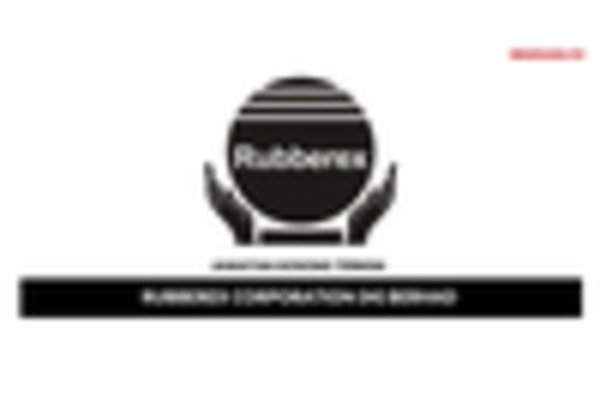Rising Healthcare Expenditure
The Latex Medical Glove Market is experiencing growth due to increasing healthcare expenditure across various regions. Governments and private sectors are investing significantly in healthcare infrastructure, which includes the procurement of medical supplies such as latex gloves. According to recent data, healthcare spending is projected to rise, driven by an aging population and the prevalence of chronic diseases. This trend indicates a sustained demand for latex medical gloves, as they are essential for maintaining hygiene and safety standards in medical settings. Furthermore, the expansion of healthcare facilities, particularly in emerging economies, is likely to bolster the market, as these facilities require a consistent supply of latex gloves to ensure compliance with health regulations. Thus, the rising healthcare expenditure is a pivotal driver for the Latex Medical Glove Market.
Increased Regulatory Standards
The Latex Medical Glove Market is significantly influenced by the implementation of stringent regulatory standards aimed at ensuring safety and quality in medical products. Regulatory bodies are continuously updating guidelines that govern the manufacturing and distribution of medical gloves, including latex varieties. Compliance with these regulations is crucial for manufacturers, as non-compliance can lead to severe penalties and loss of market access. As a result, manufacturers are compelled to invest in quality assurance processes and certifications, which may lead to increased production costs but ultimately enhances product reliability. The heightened focus on regulatory compliance is expected to drive demand for high-quality latex gloves, as healthcare providers seek to mitigate risks associated with substandard products. Therefore, the increased regulatory standards serve as a significant driver for the Latex Medical Glove Market.
Expansion of the Pharmaceutical Sector
The Latex Medical Glove Market is poised for growth due to the expansion of the pharmaceutical sector, which relies heavily on latex gloves for various applications. As pharmaceutical companies increase their production capacities and invest in research and development, the demand for latex gloves is expected to rise correspondingly. Latex gloves are essential in laboratory settings, during drug formulation, and in clinical trials, where maintaining sterile conditions is paramount. Recent statistics indicate that the pharmaceutical industry is experiencing robust growth, driven by innovations in drug development and an increasing focus on biopharmaceuticals. This expansion necessitates a reliable supply of latex gloves to ensure compliance with safety protocols. Therefore, the growth of the pharmaceutical sector is a significant driver for the Latex Medical Glove Market.
Growing Awareness of Infection Control
The Latex Medical Glove Market is benefiting from a heightened awareness of infection control practices among healthcare professionals and institutions. The recognition of the importance of personal protective equipment, including latex gloves, in preventing the transmission of infections is becoming more pronounced. Educational initiatives and training programs are being implemented to promote best practices in infection control, which in turn drives the demand for latex gloves. Data suggests that healthcare-associated infections (HAIs) remain a critical concern, prompting healthcare facilities to adopt stringent infection control measures. Consequently, the increased emphasis on infection prevention is likely to sustain the demand for latex medical gloves, as they are a fundamental component of personal protective equipment. This growing awareness of infection control is a key driver for the Latex Medical Glove Market.
Technological Innovations in Production
The Latex Medical Glove Market is being propelled by technological innovations in the production processes of latex gloves. Advances in manufacturing technologies, such as automation and improved quality control systems, are enhancing the efficiency and output of latex glove production. These innovations not only reduce production costs but also improve the quality and consistency of the gloves produced. Furthermore, the integration of smart technologies in manufacturing processes allows for real-time monitoring and adjustments, ensuring that the gloves meet stringent quality standards. As manufacturers adopt these advanced technologies, they are likely to increase their market share by offering superior products that meet the evolving needs of healthcare providers. Thus, technological innovations in production serve as a crucial driver for the Latex Medical Glove Market.


















Leave a Comment